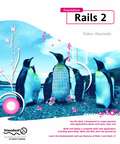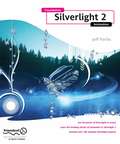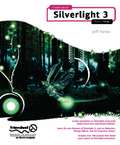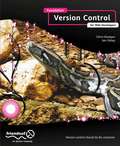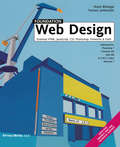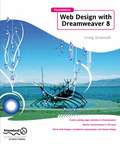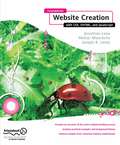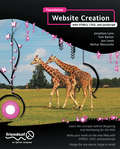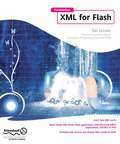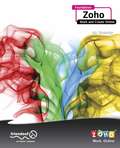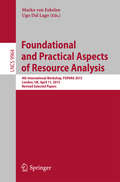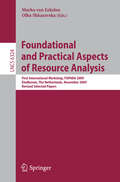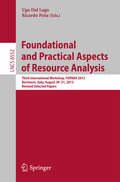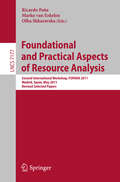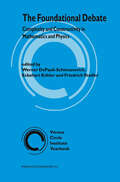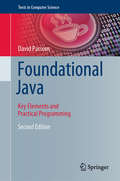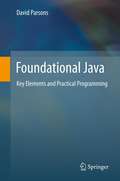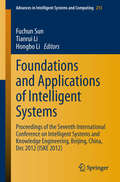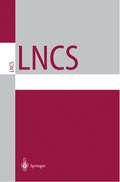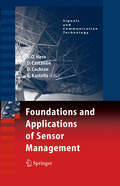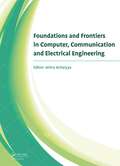- Table View
- List View
Foundation Rails 2
by Eldon AlamedaYou've heard about this amazing web framework called Ruby on Rails that's taken the world by storm, but thought it was way too complex for you? Think again. Foundation Rails 2 takes you through your first steps in Rails, explaining in plain English how to start building dynamic web applications. And there's never been a better time to jump in to the Rails world, as the release of Rails 2 was a major evolutionary leap forward from previous versions. Unlike other Rails books, this book doesn't throw you into the deep end right away in the hopes that you'll learn to swim. Instead, we'll start out with the basics and continually expand your knowledge until, by the end of the book, we're building a Rails application with dynamic features such as user registration, geocoding, filtering results with AJAX, RSS feeds, and an XML interface. Meanwhile, we'll talk about the important issues that other books often leave out such as testing your application's code, securing your application from hackers, optimizing your code for the best performance, and of course, deploying your application. This book takes a focused approach to guiding you through understanding how the pieces of Rails work individually and how they fit together. Instead of emphasizing boring theoretical discussions, Foundation Rails 2 lets you get your hands dirty with the framework and learn the hows and whys of Rails faster than ever. We start with a tour of what makes Rails special and why you need to learn it, move into a gentle introduction to the high points of programming in Ruby, and then take a tour of a sample Rails application. Next, we dig deeper into the core components of Rails before building a complete Rails application together. By the end of this book, not only will you know how to build Rails applications but you'll understand the reasons behind what you do.
Foundation Silverlight 2 Animation
by Jeff PariesSee the power of Silverlight in action Learn the building blocks of animation in Silverlight 2 Includes over 180 example Silverlight projects Silverlight is a phenomenally powerful animation tool, but few people know how to unlock its potential. Foundation Silverlight 2 Animation gives you the keys to all of that power. It covers the basics of animation—that is, Silverlight's storyboards and animations, which are used to provide interactivity to Silverlight applications. You'll take an in-depth look at double, point, and color animations. You'll also learn the difference between linear, spline, and discrete keyframes, and how they affect your objects as they move. But it doesn't stop there. You'll go well beyond those simple timeline-based animations and learn how to create purely code-based animations. You'll use vectors to make objects move and bounce off boundaries and each other. You'll explore particle systems, kinematics, and collisions. You'll also learn how to use trigonometry to animate objects and simulate 3D motion in a 2D environment. The essential trigonometry required to create complex motion is simplified and explained through a series of fascinating and fun examples that can be incorporated into your own applications, games, and experiments. Whether you're already familiar with Silverlight and you want to learn how to open it up, a Flash developer interested in expanding your skill set, or a web developer looking to take the next step into rich interactive application development, this book will bring you up to speed on Silverlight 2 and show you what it can do. From techniques for creating frame-based animations to learning how to simulate 3D in a 2D environment, there is something here to satisfy anyone's appetite for animation and interactivity.
Foundation Silverlight 3 Animation
by Jeff PariesSilverlight is Microsoft's breakthrough technology for creating rich experiences on the web. This book illustrates the power of Silverlight as a graphics, animation, and game-creation tool. It teaches the fundamentals of computer animation, using trigonometry and vector movement before moving on to more advanced topics such as physics modeling and particle systems. With full code examples for all types of animation and interaction, this is an invaluable resource for both Silverlight beginners and more advanced users. Fully updated for Silverlight 3 See the power of Silverlight in action Learn the building blocks of animation in Silverlight 2
Foundation Version Control for Web Developers
by Chris Kemper Ian OxleyFoundation Version Control for Web Developers explains how version control works, what you can do with it and how. Using a friendly and accessible tone, you will learn how to use the three leading version control systems—Subversion, Git and Mercurial—on multiple operating systems. The history and integral concepts of version control are covered so that you will gain a thorough understanding of the subject, and why it should be used to manage all changes in web development projects. This book covers the valuable knowledge and transferable skills that will enable you use one of the three leading systems as well as easily switch to new systems that will arise in the workplace. Topics covered include: How to choose the correct software for your needs. Creating and working with repositories. Understanding trunks, branches, hooks, conflicts and merging. Setting up respository servers and integrating with Apache. Using Terminal, and understanding alternatives. Foundation Version Control for Web Developers is a concise beginner’s course for designer and developer alike. Even if you have no prior knowledge of version control, this book will provide you with the knowledge to fully manage projects from start to finish, ensuring your projects are as seamless and successful as you need them to be.
Foundation Web Design
by Sham Bhangal Tomasz JankowskiWant to create a top-level website from scratch, but dont know where to start? Well, youve got a choice: buy this book, or buy ten others… Creating a website in today's environment is no longer a question of knowing about one piece of software, or one technology. To achieve the best results, you need broad knowledge on a range of topics: HTML to create pages Cascading Style Sheets (CSS) to format your text JavaScript to create interactivity Image editing software like Fireworks and Photoshop to prepare images Macromedia Flash to add multimedia content Foundation Web Design is a step-by-step guide to stunning website creation. Starting with the basics, and assuming no prior knowledge, Sham Bhangal cuts through the jargon and introduces a wide range of essential skills and technologies. These combine to help you create a fully operational and graphically stunning case study website. About the Authors: Sham Bhangal's unique tutorial style has found success in friends of ED Foundation titles such as Foundation ActionScript, heralded by Amazon.com as “perhaps one of the finest introductory programming books ever written.” Tomasz Jankowski—who designed the case study site—has won numerous web design awards. His stunning artwork first appeared in our landmark title New Masters of Flash.
Foundation Web Design with Dreamweaver 8
by Craig Grannell*Supports the new version of Dreamweaver; a huge potential market—over 3 million users worldwide *Unique within that market: purely based on web design (and not server-side functionality) teaching professional techniques *Task–based approach makes learning quick and easy
Foundation Website Creation with CSS, XHTML, and JavaScript
by Steve Smith Jonathan LaneFoundation Website Creation with CSS, XHTML, and JavaScript covers the entire process of building a website. This process involves much more than just technical knowledge, and this book provides you with all the information you'll need to understand the concepts behind designing and developing for the Web, as well as the best means to deliver professional, best-practice-based results. There is far more to building a successful website than knowing a little Hypertext Markup Language (HTML). The process starts long before any coding takes place, and this book introduces you to the agile development process, explaining why this method makes so much sense for web projects and how best to implement it. Planning is vital, so you'll also learn how to use techniques such as brainstorming, wireframes, mockups, and prototypes to get your project off to the best possible start and help ensure smooth progress as it develops. An understanding of correct, semantic markup is essential to any web professional, so this book explains how XHTML should be used to structure content so that the markup adheres to current web standards. You'll learn about the wide range of HTML elements available to you, and you'll learn how and when to use them through building example web pages. Without creative use of Cascading Style Sheets (CSS), websites would all look largely the same. CSS gives you the ability to set your website apart from the rest while maintaining the integrity of your markup. You'll learn how CSS works and how to apply styles to your pages, enabling you to realize your design ideas in the browser. JavaScript can be used to make your website easier and more interesting to use. This book provides information on appropriate uses of this technology and introduces the concepts of programming using it. You'll also see how JavaScript works as part of the much-hyped technique Ajax and in turn where Ajax fits into the wider Web 2.0 picture. While a website is being built, it needs to be tested across multiple browsers and platforms to ensure that the site works for all users, regardless of ability or disability, and the book explains how best to do these tasks. Then, it discusses the process of launching and maintaining the site so that it will continue to work for all its users throughout its life-cycle. The book concludes by covering server-side technologies, acting as a guide to the different options available and explaining differences between available products. With insights from renowned experts such as Jason Fried of 37signals, Daniel Burka of Digg and Pownce, and Chris Messina of Citizen Agency, this book provides invaluable information applicable to every web project, regardless of size, scope, or budget.
Foundation Website Creation with HTML5, CSS3, and JavaScript
by Joe Lewis Jonathan Lane Meitar Moscovitz Tom BarkerFoundation Website Creation with HTML5, CSS3, and JavaScript shows the entire process of building a website. This process involves much more than just technical knowledge, and this book provides all the information you'll need to understand the concepts behind designing and developing for the Web, as well as the best means to deliver professional results based on best practices. Of course, there is far more to building a successful website than knowing a little Hypertext Markup Language (HTML). The process starts long before any coding takes place, and this book introduces you to the agile development process, explaining why this method makes so much sense for web projects and how best to implement it. We also make sure you're up to date by using the latest HTML5 features. Planning is vital, so you'll also learn to use techniques such as brainstorming, wireframes, mockups, and prototypes to get your project off to the best possible start and help ensure smooth progress as it develops. An understanding of correct, semantic markup is essential for any web professional; this book explains how HTML5 should be used to structure content so that the markup adheres to current web standards. You'll learn about the wide range of HTML5 elements available to you, and you'll learn how and when to use them through building example web pages. Without creative use of Cascading Style Sheets (CSS), websites would all look largely the same. CSS enables you to set your website apart from the rest, while maintaining the integrity of your markup. We'll showcase the new features of CSS3 and how you can use them. You'll learn how CSS3 works and how to apply styles to your pages, allowing you to realize your design ideas in the browser. JavaScript can be used to make your website easier and more interesting to use. This book provides information on appropriate uses of this technology and introduces the concepts of JavaScript programming. You'll also see how JavaScript works as part of the much-hyped technique Ajax, and in turn, where Ajax fits into the wider Web 2.0 picture. While a website is being built, it needs to be tested across multiple browsers and platforms to ensure that the site works for all users, regardless of ability or disability, and this book explains how best to accomplish these tasks. Then, it discusses the process of launching and maintaining the site so that it will continue to work for all its users throughout its life cycle. Foundation Website Creation with HTML5, CSS3, and JavaScript concludes by covering server-side technologies, acting as a guide to the different options available. With insights from renowned experts such as Jason Fried of 37signals, Daniel Burka of Digg and Pownce, and Chris Messina of Citizen Agency, Foundation Website Creation with CSS, XHTML, and JavaScript provides invaluable information applicable to every web project—regardless of size, scope, or budget.
Foundation XML and E4X for Flash and Flex
by Sas JacobsXML is the lingua franca of the Web. All designers and developers working in a web environment need a sound understanding of XML and its role in application development. Many software packages and organizations allow for the exchange of data using an XML format. Web services and RSS feeds are now commonplace. For those working with Flash and Flex, a thorough understanding of XML is particularly important. XML documents are one option for the data provided to SWF applications. Flash and Flex can load, display, and modify XML content. These applications can also send XML content to other applications for updating or for use in different situations. ActionScript 3.0 introduced some fundamental changes to the way in which Flash and Flex applications work with XML. One significant change is that XML is now a native data type. ActionScript 3.0 also introduced new classes and a different framework for working with external documents. These changes are based on the E4X ECMAScript standard, and they streamline and simplify the process for working with XML in Flash and Flex. In Foundation XML and E4X for Flash and Flex, Sas Jacobs gives you an introduction to XML and E4X. She explores the XML and XMLList classes and explains E4X expressions, providing examples for both Flash and Flex. In addition to explaining how to incorporate XML documents in Shockwave Flash applications, Sas shows you approaches specific to Flash and Flex and explores real-world usage. The book finishes with two case studies. In the first, you will learn how to consume and display information and images from Flickr using Flash. In the second, you will work with Adobe Kuler in Flex. Whether you are a designer or developer, this book will help you work with XML and make the transition from ActionScript 2.0 to ActionScript 3.0. It will also provide you with an excellent grounding if you are new to Flash and Flex.
Foundation XML for Flash
by Sas Jacobs* Potentially huge market, due to Rich Internet Applications growing in popularity, and Microsoft Office and .NET development being so popular – this books shows how to use XML and Flash to integrate these MS technologies with simple Rich Internet Applications. * There is no other book on the market that covers this topic area. * Book supports next version of Flash, which is also a large market area.
Foundation Zoho: Work and Create Online
by Ali ShabdarWith more than 1.3 million users and growing every week, Zoho.com is a popular online suite of productivity applications that include email, word processor, spreadsheet, accounting, collaboration, social networking and other creative tools. It's basically like having an online version of Microsoft Office, and Google Apps. And do you know what's great about Zoho? It's cost efficient and free depending on the services you choose; it's hosted on their servers; little or no tech support will ever be needed; and it runs nicely on thin clients like netbooks or smartphones like the iPhone. Also, according to CIO Magazine: "[Zoho has] got more applications than Google… The apps they have are richer." Foundation Zoho gets you started with the vibrant Zoho.com and shows you how to use it for day-to-day tasks as well as have fun with it. This book also helps you to utilize Zoho with iPhone or even with Microsoft Office, if you still wish to use it.
Foundational and Practical Aspects of Resource Analysis: 4th International Workshop, FOPARA 2015, London, UK, April 11, 2015. Revised Selected Papers (Lecture Notes in Computer Science #9964)
by Marko Van Eekelen Ugo Dal LagoThis book constitutes the proceedings of the 4th International Workshop on Foundational and Practical Aspects of Resource Analysis, FOPARA 2015, held in London, UK, in April 2015. The 6 papers presented in this volume were carefully reviewed and selected from 7 submissions.
Foundational and Practical Aspects of Resource Analysis: First International Workshop, FOPARA 2009, Eindhoven, The Netherlands, November 6, 2010, Revised Selected Papers (Lecture Notes in Computer Science #6324)
by Marko Van Eekelen Olha ShkaravskaFoundational and Practical Aspects of Resource Analysis: Third International Workshop, FOPARA 2013, Bertinoro, Italy, August 29-31, 2013, Revised Selected Papers (Lecture Notes in Computer Science #8552)
by Ugo Dal Lago Ricardo PeñaThis book constitutes the proceedings of the Third International Workshop on Foundational and Practical Aspects of Resource Analysis, FOPARA 2013, held in Bertinoro, Italy, in August 2013. The 9 papers presented in this volume were carefully reviewed and selected from 12 submissions. They deal with traditional approaches to complexity analysis, differential privacy, and probabilistic analysis of programs.
Foundational and Practical Aspects of Resource Analysis: Second International Workshop, FOPARA 2011, Madrid, Spain, May 19, 2011, Revised Selected Papers (Lecture Notes in Computer Science #7177)
by Ricardo Peña Marko Van Eekelen Olha ShkaravskaThis book constitutes the refereed post-proceedings of the Second International Workshop on Foundational and Practical Aspects of Resource Analysis, FOPARA 2011, held in Madrid, Spain, in May 2011. The 8 revised full papers were carefully reviewed and selected from the papers presented at the workshop and papers submitted following an open call for contributions after the workshop. The papers are organized in the following topical sections: implicit complexity, analysis and verfication of cost expressions, and worst case execution time analysis.
The Foundational Debate: Complexity and Constructivity in Mathematics and Physics (Vienna Circle Institute Yearbook #3)
by Werner DePauli-Schimanovich Eckehart Köhler F. StadlerConstructibility and complexity play central roles in recent research in computer science, mathematics and physics. For example, scientists are investigating the complexity of computer programs, constructive proofs in mathematics and the randomness of physical processes. But there are different approaches to the explication of these concepts. This volume presents important research on the state of this discussion, especially as it refers to quantum mechanics. This `foundational debate' in computer science, mathematics and physics was already fully developed in 1930 in the Vienna Circle. A special section is devoted to its real founder Hans Hahn, referring to his contribution to the history and philosophy of science. The documentation section presents articles on the early Philipp Frank and on the Vienna Circle in exile. Reviews cover important recent literature on logical empiricism and related topics.
Foundational Java: Key Elements and Practical Programming (Texts in Computer Science)
by David ParsonsJava is now well-established as one of the world’s major programming languages, used in everything from desktop applications to web-hosted applications, enterprise systems and mobile devices. Java applications cover cloud-based services, the Internet of Things, self-driving cars, animation, game development, big data analysis and many more domains.The second edition of Foundational Java: Key Elements and Practical Programming presents a detailed guide to the core features of Java – and some more recent innovations – enabling the reader to build their skills and confidence though tried-and-trusted stages, supported by exercises that reinforce the key learning points. All the most useful and commonly applied Java syntax and libraries are introduced, along with many example programs that can provide the basis for more substantial applications. Use of the Eclipse Integrated Development Environment (IDE) and the JUnit testing framework is integral to the book, ensuring maximum productivity and code quality when learning Java, although to ensure that skills are not confined to one environment the fundamentals of the Java compiler and run time are also explained. Additionally, coverage of the Ant tool will equip the reader with the skills to automatically build, test and deploy applications independent of an IDE.Topics and features:• Presents the most up-to-date information on Java, including Java 14• Examines the key theme of unit testing, introducing the JUnit 5 testing framework to emphasize the importance of unit testing in modern software development• Describes the Eclipse IDE, the most popular open source Java IDE and explains how Java can be run from the command line• Includes coverage of the Ant build tool• Contains numerous code examples and exercises throughout• Provides downloadable source code, self-test questions, PowerPoint slides and other supplementary material at the website http://www.foundjava.comThis hands-on, classroom-tested textbook/reference is ideal for undergraduate students on introductory and intermediate courses on programming with Java. Professional software developers will also find this an excellent self-study guide/refresher on the topic.Dr. David Parsons is National Postgraduate Director at The Mind Lab, Auckland, New Zealand. He has been teaching programming in both academia and industry since the 1980s and writing about it since the 1990s.
Foundational Java: Key Elements and Practical Programming (Texts In Computer Science Ser.)
by David ParsonsThis book presents a guide to the core features of Java – and some more recent innovations – enabling the reader to build skills and confidence though tried-and-trusted stages, supported by exercises that reinforce key learning points. All of the most useful and commonly applied Java syntax and libraries are introduced, along with many example programs that can provide the basis for more substantial applications. Use of the Eclipse IDE and the JUnit testing framework is integral to the book, ensuring maximum productivity and code quality, although to ensure that skills are not confined to one environment the fundamentals of the Java compiler and run time are also explained. Additionally, coverage of the Ant tool will equip the reader with the skills to automatically build, test and deploy applications independent of an IDE. Features: presents information on Java 7; contains numerous code examples and exercises; provides source code, self-test questions and PowerPoint slides at an associated website.
Foundations and Applications of Intelligent Systems: Proceedings of the Seventh International Conference on Intelligent Systems and Knowledge Engineering, Beijing, China, Dec 2012 (ISKE 2012) (Advances in Intelligent Systems and Computing #213)
by Fuchun Sun Tianrui Li Hongbo LiThese proceedings present technical papers selected from the 2012 International Conference on Intelligent Systems and Knowledge Engineering (ISKE 2012), held on December 15-17 in Beijing. The aim of this conference is to bring together experts from different fields of expertise to discuss the state-of-the-art in Intelligent Systems and Knowledge Engineering, and to present new findings and perspectives on future developments. The proceedings introduce current scientific and technical advances in the fields of artificial intelligence, machine learning, pattern recognition, data mining, knowledge engineering, information retrieval, information theory, knowledge-based systems, knowledge representation and reasoning, multi-agent systems, and natural-language processing, etc. Furthermore they include papers on new intelligent computing paradigms, which combine new computing methodologies, e.g., cloud computing, service computing and pervasive computing with traditional intelligent methods. By presenting new methodologies and practices, the proceedings will benefit both researchers and practitioners who want to utilize intelligent methods in their specific fields. Dr. Fuchun Sun is a professor at the Department of Computer Science & Technology, Tsinghua University, China. Dr. Tianrui Li is a professor at the School of Information Science & Technology, Southwest Jiaotong University, Chengdu, China. Dr. Hongbo Li also works at the Department of Computer Science & Technology, Tsinghua University, China.
Foundations and Applications of Multi-Agent Systems: UKMAS Workshop 1996-2000, Selected Papers (Lecture Notes in Computer Science #2403)
by Mark D'Inverno Michael Luck Michael Fisher Christ PreistThis book presents revised full versions of papers contributed to UK Workshops on Multi-Agent Systems, UKMAS, during 1996 and 2000.From the early days of MAS research, the UK community has been a particularly productive one with numerous key contributions. The 15 papers by internationally reputed researchers deal with various aspects of agent technology, with a certain emphasis on foundational issues in multi-agent systems.
Foundations and Applications of Security Analysis: Joint Workshop on Automated Reasoning for Security Protocol Analysis and Issues in the Theory of Security, ARSPA-WITS 2009, York, UK, March 28-29, 2009, Revised Selected Papers (Lecture Notes in Computer Science #5511)
by Pierpaolo Degano Luca ViganòFoundations and Applications of Sensor Management (Signals and Communication Technology)
by Doug Cochran Alfred Olivier Hero David Castañón Keith KastellaThis book covers control theory signal processing and relevant applications in a unified manner. It introduces the area, takes stock of advances, and describes open problems and challenges in order to advance the field. The editors and contributors to this book are pioneers in the area of active sensing and sensor management, and represent the diverse communities that are targeted.
Foundations and Frontiers in Computer, Communication and Electrical Engineering: Proceedings of the 3rd International Conference C2E2, Mankundu, West Bengal, India, 15th-16th January, 2016.
by Aritra AcharyyaThe 3rd International Conference on Foundations and Frontiers in Computer, Communication and Electrical Engineering is a notable event which brings together academia, researchers, engineers and students in the fields of Electronics and Communication, Computer and Electrical Engineering making the conference a perfect platform to share experience, f
Foundations and Fundamentals in Human-Computer Interaction
by Gavriel Salvendy Constantine StephanidisThis book serves as a foundation to the field of HCI, equipping readers with the necessary knowledge and skills to engage in this field. This book Discusses human functionalities and characteristics relevant to interaction, including sensory perception, attention and memory, language and communication, emotions, decision-making, as well as mental models, human error, and human actions. Explores the evolution of HCI design approaches and the role of social and organizational psychology in HCI Discusses key concepts and societal aspects of interactive technologies, such as user acceptance, ethics, privacy, and trust. Covers the historical background, contributing disciplines, essential concepts, and theories within the domain. This book will appeal to individuals interested in Human–Computer Interaction research and applications.
Foundations and Fundamentals in Human-Computer Interaction
by Gavriel Salvendy Constantine StephanidisThis book serves as a foundation to the field of HCI, equipping readers with the necessary knowledge and skills to engage in this field. This book Discusses human functionalities and characteristics relevant to interaction, including sensory perception, attention and memory, language and communication, emotions, decision-making, as well as mental models, human error, and human actions. Explores the evolution of HCI design approaches and the role of social and organizational psychology in HCI Discusses key concepts and societal aspects of interactive technologies, such as user acceptance, ethics, privacy, and trust. Covers the historical background, contributing disciplines, essential concepts, and theories within the domain. This book will appeal to individuals interested in Human–Computer Interaction research and applications.
